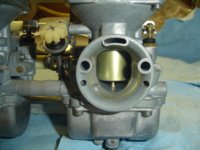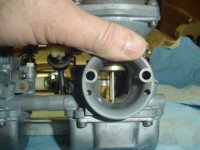rugbywarrior89
Need more time...
So it turns out my start button is fine. It's the kill switch that is backwards. From what I can tell, the kill switch is designed for a bike where the circuit is normally open while in operation, then you close it (I assume short the coil) to shut the bike off. The xs400 apparently needs a closed circuit to run. I turned the switch to the off position and pressed the button just to see and Voila! it turned right over.
However, now I have a problem with my headlight. It was working then it just stopped. I went all the way back to the relay. I couldn't find a 12V charge to the relay so my first thought was it must be a fuse but all my fuses are fine. I had to buy a relay for it a few months back as well so I wonder if something is killing the relay as well. Anyone ever had a problem like this? Could anyone tell me what color the wire is that should be providing my 12V constant? The wire running to the headlight is blue/black.
Also, I sill don't have any clue whats wrong with my turn signals, they just won't work. I grounded that yellow/red wire just to see what would happen and something under the seat just started freaking out like it was clicking but so fast it sounded like a buzz, even after I pulled the wire off. Once I shut the key off and turned it back on, it was fine. Any ideas? Did I break something?
However, now I have a problem with my headlight. It was working then it just stopped. I went all the way back to the relay. I couldn't find a 12V charge to the relay so my first thought was it must be a fuse but all my fuses are fine. I had to buy a relay for it a few months back as well so I wonder if something is killing the relay as well. Anyone ever had a problem like this? Could anyone tell me what color the wire is that should be providing my 12V constant? The wire running to the headlight is blue/black.
Also, I sill don't have any clue whats wrong with my turn signals, they just won't work. I grounded that yellow/red wire just to see what would happen and something under the seat just started freaking out like it was clicking but so fast it sounded like a buzz, even after I pulled the wire off. Once I shut the key off and turned it back on, it was fine. Any ideas? Did I break something?

 so I soldered that but I haven't delved into the rest of the fuses much.
so I soldered that but I haven't delved into the rest of the fuses much. ) and figured out that there is a neutral that goes to the canceler. I tried to Macgyver the bronze tab back into the new switch but that didn't work. Then I found the forum about bypassing the canceler all together. DO NOT ground the the green/yellow wire on the flasher relay for future viewers. After all that, I still only got one side to work so I changed the relay with a autozone cheapo. both sides worked great...for a minute then one back light stopped blinking. Somehow (and I'm still not sure how) the ground from the light bulb didn't have connection to the stud of the signal mount even though it's one solid piece of metal
) and figured out that there is a neutral that goes to the canceler. I tried to Macgyver the bronze tab back into the new switch but that didn't work. Then I found the forum about bypassing the canceler all together. DO NOT ground the the green/yellow wire on the flasher relay for future viewers. After all that, I still only got one side to work so I changed the relay with a autozone cheapo. both sides worked great...for a minute then one back light stopped blinking. Somehow (and I'm still not sure how) the ground from the light bulb didn't have connection to the stud of the signal mount even though it's one solid piece of metal . Besides I need to get a little return on investment before I start any mire projects.
. Besides I need to get a little return on investment before I start any mire projects.
